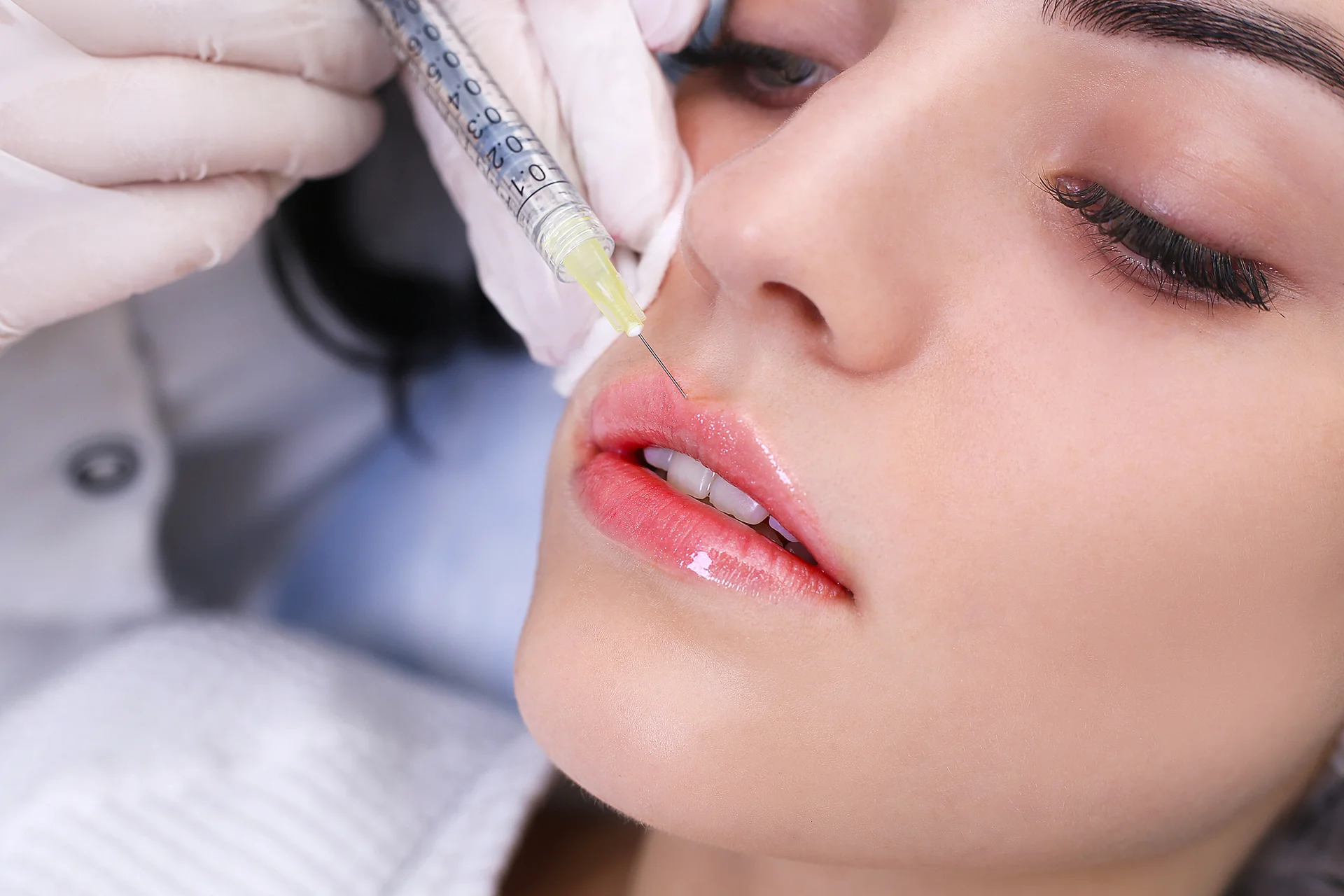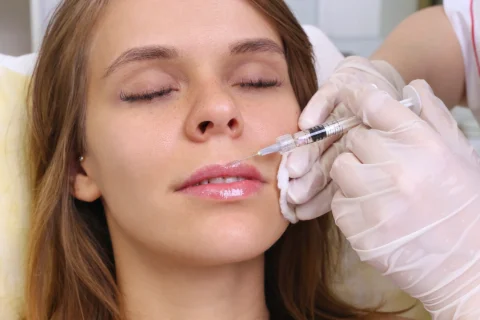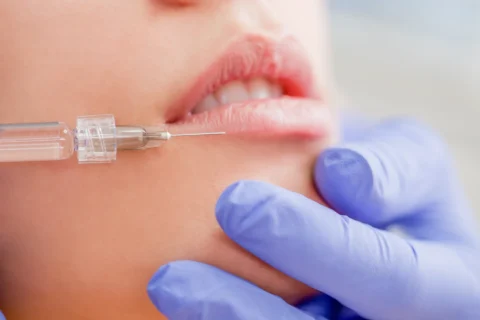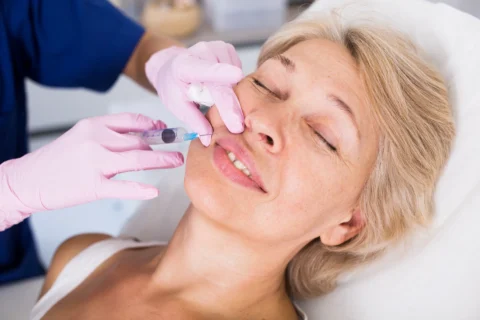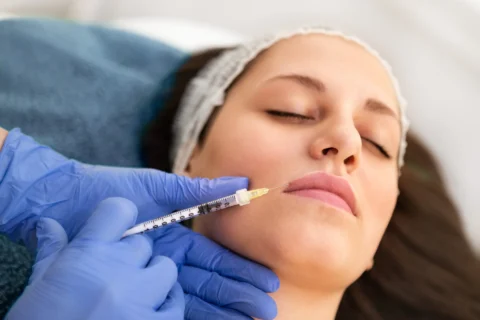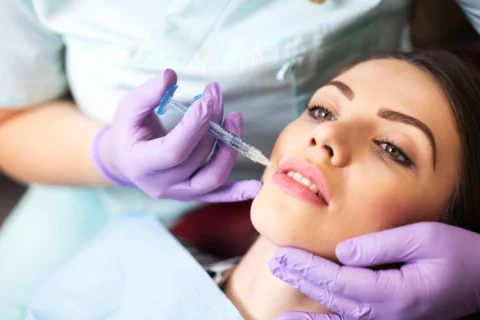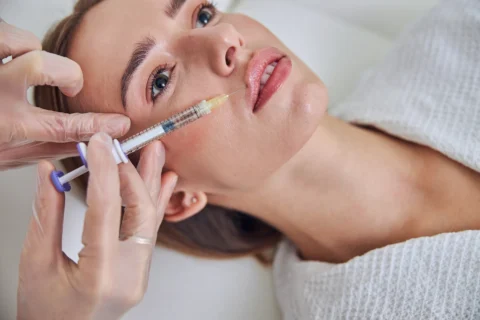Lip fillers have become more popular over the past decade, as more and more people seek non-invasive, safe, and effective ways to enhance their facial appearance and boost their self-esteem. Given the advancements in cosmetic medicine, patients can now choose from a range of filler options to achieve their desired lip goals – whether that’s lip volume, reshaping, symmetry, or all of the above.
So what are the different types of lip fillers? In this article, we discuss in further detail the benefits and drawbacks of calcium hydroxylapatite, hyaluronic acid, polyalkylimide, polylactic acid, and polymethyl-methacrylate (PMMA) microspheres. It’s crucial that you understand how each of these can contribute to your aesthetic goals so that you can make a decision with confidence and clarity.
Different Types of Lip Fillers
1) Calcium Hydroxylapatite
Calcium hydroxylapatite is a non-toxic substance derived from a naturally occurring mineral found in our bones and teeth. Since it’s a biocompatible substance, it can be safely injected into the body without causing adverse reactions. It stimulates collagen production, making it the go-to option for patients seeking a more pronounced lip volumizing effect. Results last up to 12 months.
One of the most popular lip filler brands that uses this ingredient is Radiesse, which costs about $600 to $1,000 per syringe. Keep in mind that this particular ingredient may not be suitable for patients with very thin lips and low pain tolerance due to its thick consistency.
2) Hyaluronic Acid
Hyaluronic acid is also a naturally occurring enzyme found in the human body, particularly in the skin, connective tissues, and eyes. It’s a type of sugar molecule that holds a large amount of water and thus restores the volume and hydrated appearance of the treatment area. This ingredient is also biodegradable – meaning its effects can be reversed by an injection of hyaluronidase. Results last between 6 and 12 months.
In fact, this is one of the most common lip filler ingredients as it is found in multiple formulations such as Juvederm, Restylane, and Belotero. A hyaluronic acid-based lip filler treatment typically costs about $500 to $1,000 per injection. You may also need to undergo touch-up sessions to maximize the longevity of your results.
3) Polyalkylimide
This is a semi-permanent, biocompatible filler material that’s used for various aesthetic purposes (e.g., lip augmentation, facial contouring, deep wrinkle correction). There is a low risk of allergic reactions and other adverse side effects.
This active ingredient is also resistant to degradation, which means that results can last for up to several years. Keep in mind, however, that due to its ability to provide long-lasting effects, it can be more difficult to remove or adjust if ever you’re unsatisfied with your appearance.
Aquamid is one of the leading polyalkylimide-based lip filler brands. It’s on the pricier end as patients can expect to pay between $800 to $1,500 for each vial. Make sure to consult with an experienced practitioner.
4) Polylactic Acid
One of the many benefits of polylactic acid lip fillers is the natural and subtle enhancement you’ll experience after the procedure. Their collagen-stimulating properties gradually enhance your lip’s volume and shape over time, resulting in a more youthful and rejuvenated look. You may need to undergo multiple treatment sessions before achieving your desired results.
Sculptra uses polylactic acid for its lip filler formulation which ranges between $800 to $1,200 per treatment session. Similar to any other lip enhancement procedure, you may experience temporary side effects such as redness, swelling, or bruising that will naturally subside within a few days.
5) PMMA Microspheres
PMMA microspheres are a type of dermal filler made from tiny synthetic beads suspended in a collagen-based gel. Given that the microspheres stay in the treated area for a long time, this lip filler ingredient can be much more effective at stimulating collagen production and enhancing the lips’ appearance. The major drawback is that there is a slightly higher risk of complications (e.g., lumpiness, nodules, granulomas).
A lip filler brand that uses PMMA microspheres in its formulation is Bellafill. A single syringe costs about $1,000 to $1,500. Expect multiple touch-ups to achieve your aesthetic goals. If you’re looking for a more permanent cosmetic solution, this active ingredient might be at the top of your list of options since its results have been proven to last for up to 5 years. This also means that you need to have no doubts about your choice as it’s not easily reversible.
How to Choose the Right Dermal Filler for You
With the plethora of lip filler options at your fingertips, figuring out the right brand for you can seem overwhelming, especially if you’re nervous about how the final results would look like. To make an informed decision, consider the following factors:
- Aesthetic goals: Tell your cosmetic provider exactly what you want so that they can set realistic expectations. Do you want a subtle, natural boost or a more dramatic lip transformation? Are you okay with gradual change or immediate results? Will any allergies affect your recovery journey?
- Longevity: Different filler materials offer varying levels of longevity. Some last a few months, while others can last up to 2 years. Think about how frequently you’re willing to undergo touch-up sessions.
- Potential risks and side effects: Dermal fillers are generally safe. Should you experience any major reactions, consult your cosmetic provider immediately.
- Reviews and testimonials of the medical spa: If you want to be confident in your decision, look at the reviews of patients who have undergone similar filler treatments at your chosen medical spa.
- Budget considerations: The cost of lip filler procedures depend on a multitude of factors – from active filler ingredients, frequency of touch-ups, location of the medical spa, and the expertise of the cosmetic provider.
How Much Do Lip Fillers Cost?
Speaking of budget considerations, a lip filler injection could cost as low as $500 to as high as $1,500. As mentioned, the final cost varies significantly based on several factors, as well as how frequently you’ll have maintenance sessions. Lip fillers are often not covered by insurance as these are considered cosmetic treatments. Consult with your aesthetic practitioner for a personalized quote.
Ideal Candidate for Lip Filler Procedures
The ideal candidate for a lip augmentation procedure is someone who is in good overall health, has realistic expectations, and can religiously follow aftercare advice. While there is no strict age limit for dermal filler treatments, most patients are adults who are experiencing a loss of volume, definition, or symmetry in their lips due to aging. Younger patients can also opt for lip fillers if they’re looking for fuller or more balanced lips.
Ethos Spa: Discuss Your Lip Goals With Cosmetic Experts
The key differences between common types of dermal fillers lie in their composition, longevity, and unique benefits. Some are known for long-lasting, natural results, while others provide a gradual and subtle enhancement over time. Each filler material caters to various preferences and expectations, so it’s best to do your research to make an informed decision.
The cosmetic experts at Ethos Spa are here to help you achieve your lip enhancement goals. By discussing your goals, concerns, and needs, you’ll receive personalized guidance and recommendations for the most suitable lip filler option. Schedule a no-obligation consultation today.

